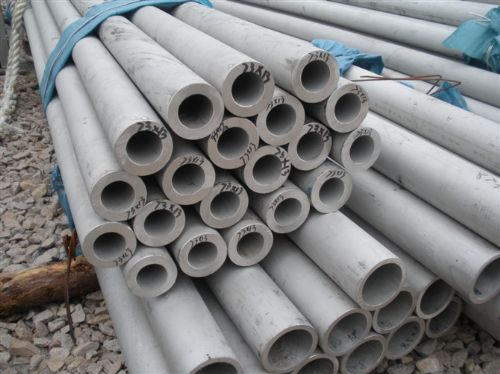Stainless steel pipe is a hollow elongated round steel material, which is widely used in petroleum, chemical, medical, food, light industry, mechanical instrumentation and other industrial pipelines and mechanical structural components. In addition, when the bending and torsional strength are the same, the weight is lighter, so it is also widely used in the manufacture of mechanical parts and engineering structures. It is also commonly used as furniture and kitchen utensils. The outer diameter of the steel pipe currently produced ranges from 0.1 to 4500mm, and the wall thickness ranges from 0.01 to 250mm. In order to distinguish its characteristics, steel pipes are usually classified as follows.
1. Production method
According to the production method, stainless steel pipes are divided into two categories: seamless steel pipes and welded steel pipes. Seamless steel pipes can be divided into hot-rolled pipes, cold-rolled pipes, cold-drawn pipes and extruded pipes, etc. Cold-drawn and cold-rolled pipes are the secondary processing of steel pipes. Welded pipes are divided into straight seam welded pipe (LSAW steel pipe) and spiral welded pipe.
2. Section shape
Stainless steel tubes can be divided into round tubes and special-shaped tubes according to the cross-sectional shape. Special-shaped tubes include rectangular tubes, diamond-shaped tubes, oval tubes, hexagonal tubes, octagonal tubes, and various asymmetrical tubes. Shaped tubes are widely used in various structural parts, tools and mechanical parts. Compared with round pipes, special-shaped pipes generally have a larger moment of inertia and section modulus, and have greater bending and torsion resistance, which can greatly reduce the structural weight and save steel.
Stainless steel pipes can be divided into equal-section pipes and variable-section pipes according to the shape of the longitudinal section. Variable cross-section pipes include tapered pipes, stepped pipes and periodic cross-section pipes, etc.

3. Tube end shape
Stainless steel pipes can be divided into plain pipes and threaded pipes (threaded steel pipes) according to the state of the pipe ends. Threaded pipes can be divided into ordinary threaded pipes (and special threaded pipes (pipes for petroleum and geological drilling, special threaded connections for important threaded pipes).
For some special pipes, in order to compensate for the influence of the thread on the strength of the pipe end, the pipe end is usually thickened (inner thickened, outer thickened or inner and outer thickened) before threading.
4. Use classification
According to the application, it can be divided into oil well pipes (casing pipe, oil pipe and drill pipe, etc.), pipeline pipes, boiler pipes, mechanical structure pipes, hydraulic prop pipes, gas cylinder pipes, geological pipes, chemical pipes and ship pipes, etc.
Summarize
According to the material, stainless steel pipes are divided into ordinary carbon steel pipes, high-quality carbon structural steel pipes, alloy structural pipes, alloy steel pipes, bearing steel pipes, stainless steel pipes, and bimetallic composite pipes, coating and coating pipes to save precious metals and meet special requirements. . There are many kinds of stainless steel pipes with different uses, their technical requirements are different, and their production methods are also different.
1. Production method
According to the production method, stainless steel pipes are divided into two categories: seamless steel pipes and welded steel pipes. Seamless steel pipes can be divided into hot-rolled pipes, cold-rolled pipes, cold-drawn pipes and extruded pipes, etc. Cold-drawn and cold-rolled pipes are the secondary processing of steel pipes. Welded pipes are divided into straight seam welded pipe (LSAW steel pipe) and spiral welded pipe.
2. Section shape
Stainless steel tubes can be divided into round tubes and special-shaped tubes according to the cross-sectional shape. Special-shaped tubes include rectangular tubes, diamond-shaped tubes, oval tubes, hexagonal tubes, octagonal tubes, and various asymmetrical tubes. Shaped tubes are widely used in various structural parts, tools and mechanical parts. Compared with round pipes, special-shaped pipes generally have a larger moment of inertia and section modulus, and have greater bending and torsion resistance, which can greatly reduce the structural weight and save steel.
Stainless steel pipes can be divided into equal-section pipes and variable-section pipes according to the shape of the longitudinal section. Variable cross-section pipes include tapered pipes, stepped pipes and periodic cross-section pipes, etc.

3. Tube end shape
Stainless steel pipes can be divided into plain pipes and threaded pipes (threaded steel pipes) according to the state of the pipe ends. Threaded pipes can be divided into ordinary threaded pipes (and special threaded pipes (pipes for petroleum and geological drilling, special threaded connections for important threaded pipes).
For some special pipes, in order to compensate for the influence of the thread on the strength of the pipe end, the pipe end is usually thickened (inner thickened, outer thickened or inner and outer thickened) before threading.
4. Use classification
According to the application, it can be divided into oil well pipes (casing pipe, oil pipe and drill pipe, etc.), pipeline pipes, boiler pipes, mechanical structure pipes, hydraulic prop pipes, gas cylinder pipes, geological pipes, chemical pipes and ship pipes, etc.
Summarize
According to the material, stainless steel pipes are divided into ordinary carbon steel pipes, high-quality carbon structural steel pipes, alloy structural pipes, alloy steel pipes, bearing steel pipes, stainless steel pipes, and bimetallic composite pipes, coating and coating pipes to save precious metals and meet special requirements. . There are many kinds of stainless steel pipes with different uses, their technical requirements are different, and their production methods are also different.









